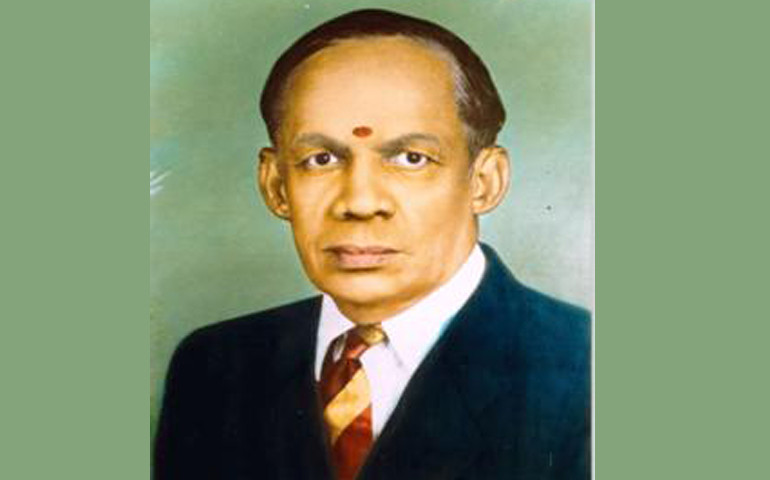[w8_row margin_bottom=”30px”]
[w8_column type=”col-md-6″]« National University of Singapore[/w8_column]
[w8_column type=”col-md-6″]
Rajesh Rai, Indians in Singapore, 1819-1945: Diaspora in the Colonial Port City, New Delhi: Oxford University Press, 2014
»[/w8_column]
[/w8_row]
A Chettinad Gem and Visionary: Dr. RM. Alagappa Chettiar – October 6th, 2014
Dr. K. Vairavan, University of Wisconsin-Milwaukee, USA
Visitors to Chettinad in Tamil Nadu, India can hardly miss the impressive cluster of academic and research institutions that now populate its largest town of Karaikudi. Chettinad was a region in India without even a single institution of higher learning till 1947. It is now the home of numerous colleges, a university, and a major national research center. What transformed Karaikudi from a remote “god-forsaken place”, as some referred to it in the late 1940s, to a vibrant town that features prominently in higher education in India? The answer lies in the grand vision, unprecedented generosity, courage and determination of one man: Dr. RM. Alagappa Chettiar, a son of Chettinad.
Alagappa Chettiar (AC) was born on April 6, 1909 in Kottayiur. In a short life span of 48 years, he became a pioneering industrialist, an intellectual, a tireless promoter of education and a philanthropist who had supported numerous causes in many parts of the country. Endowed with a brilliant mind and a magnetic personality, AC was also a warm and modest human being with a great sense of humor. He was born in an affluent family–his parents were K.V.AL. Ramanthan Chettiar and Umayal Achi. He had two older siblings, (also named) Ramanathan Chettiar and Unnamalai Achi and a younger sister Valliammai Achi. He grew up in Kottayiur and attended the Meenakshi Sundareswarar Vidyasalai (high school) in Karaikudi. After high school, his father wanted him to pursue the family’s successful and traditional money lending business in Malaya and Singapore, but he chose the path of higher education and attended the Presidency College, Madras beginning in 1925. He graduated from the Madras University with an honors degree in English Literature in 1930.
He enjoyed a happy academic and social life at the prestigious Presidency College that was enriched by brilliant classmates like S.Y. Krishnaswamy, V.S.Jayaraman and S. Chandreshekar (who later became a Nobel laureate and a famous astrophysicist). But he endured many early tragedies in family life. First, he lost both his parents while he was still a teenager, and lost his first wife Valli Achi in 1928, just days after she had given birth to his only daughter Umayal. His young daughter was cared for by her maternal grandmother and aunt. His older brother arranged AC’s second marriage in 1929 to Lakshmi achi.
After graduation from the Presidency College at the age of 21, AC went to England for higher studies. He spent the next three years (1930-1933) in London studying to become a Barrister-at-law. During this period, AC also obtained valuable banking experience at the famous Chartered Bank as a trainee. AC led an active life in London, learning to fly and obtaining a pilot’s license at Croydon. Unfortunately he returned to India in 1933 as an ill man.
AC did not let his illness prevent him from moving forward in pursuing bold new businesses. He broke from the traditional family business in Malaya and Singapore and brought his inheritance to India to start new and ambitiousbusiness projects. These included textile mills in Cochin and Travancore states (that would later become part of the state of Kerala), stock trading company, insurance company, real estate holdings including the Ritz Hotel in Bombay, and a private airline —Jupiter Airways. He was also an active leader in modern banking circles, serving as a Director of the Indian Overseas Bank and the Indian Bank.In collaboration with his friend and neighbor, M.CT. Chidambaram Chettiar, AC was also involved in other business ventures, and in a matter of a decade after his return from England, he had established himself as a major industrialist and a business leader in India. What distinguished AC from most other industrialists of his time was the fact that he had also become a well- known philanthropist and an intellectual.
AC’s extraordinary generosity reached many parts of India and ranged over an amazingly broad array of great causes. Cochin and Travancore, homes of his thriving textile mills, benefitted in many ways from AC’s charity. For example, he built a hospital for the welfare of his employees in Cochin. He gave generously to the University of Travancore to establish a Tamil studies program, to fund research in geothermal studies and to support students’ study of technology overseas. He also supported Travancore’s ambitious free midday lunch program for school children—a program that would be duplicated in other parts of the country later. Such programs were designed to encourage students from poor families to attend schools.
Two of AC’s early charities took his philanthropy to unprecedented levels in India. First in 1943, he made a large gift of Rs. 500,000 to Annamalai University to start a program in technology. Soon after that, he made an identical large gift to the University of Madras to start a college of technology in Guindy, Madras (Rs. 500,000 in 1943 was an extremely large sum). Both gifts were motivated by his farsighted view of the importance of educating students in technology as a way to economically advance a poor nation. Both universities expressed their gratefulness by awarding AC with Honorary Doctorates. In 1945, the British Government, then ruling India, recognized AC’s vast accomplishments in business and philanthropy by honoring him with a Knighthood. AC, who was only 35 years old at the time,came to be known as Dr. Sir. RM. Alagappa Chettiar. In Tamil, it became common practice to address him as Vallal Alagappa Chettiar.
In 1943, AC celebrated his only daughter Umayal’s marriage in a unique way. It was the grandest wedding Chettinad has ever seen or will likely ever see in the future. Umayal’s marriage to AC’s sister Unnamalai achi’s son VE. Ramanathan was celebrated over 4 days of festive activities in Kottaiyur. What was particularly special about the event was that it was enhanced by over 20 stellar music and dance performances by leading artistes from South India. The event was a blend of a grand wedding and a great arts festival. Just as important was a noble and an unusual feature that characterized the wedding. AC used the happy occasion to formally announce many major philanthropic gifts.
In 1947, as AC continued his remarkable journey in business and philanthropy, India became an independent nation after many years of struggle for freedom. AC was among the great Indian industrialists who were keen on helping India become a modern nation.The period 1947-1957, the last decade in AC’s short life, was marked by AC’s continued great accomplishments and contributions to society. Unfortunately, towards the end of the decade, AC experienced poor health and endured great pain and suffering.
In July 1947, inspired by a speech by the Vice-Chancellor of Madras University, Dr. A. Lakshmanaswamy Mudaliar at a public event, AC spontaneously made a dramatic pledge to start a college in Ramnad District where Chettinad was located. In his speech, Dr. Mudaliar had exhorted industrialists to start colleges in rural areas so as to make higher education accessible to young citizens in these regions. Within months AC started the Alagappa Chettiar Arts College in Karaikudi—the first of its kind in Chettinad. Amazingly, AC soon developed a grand vision of building a cluster of academic institutions—including colleges in sciences, humanities and professions—in a region of India that did not house even a single institution of higher learning. In 1948, he wrote to his friend and supporter, SA. Ganesan of Karaikudi:
“My only prayer is that we should all march together through thick and thin to achieve the great and laudable objectives that we have in view, i.e., to build up a congregation of academic units imbued with the highest ideals.”
Just a few months later, AC learned of the Indian Central Government’s plan to start a national research center in Electrochemistry to promote industrial research. He jumped at the idea and wanted its location to be Karaikudi. He travelled to Delhi in January 1948, and personally made a bold proposal to Prime Minister Jawaharlal Nehru. He made a generous offer of 300 acres of land in Karaikudi near his college campus and Rs. 1.5 million (again a vast sum in 1948). Against overwhelming odds—since Karaikudi was thought to be a remote town in “the middle of no-where”– AC was determined in his pursuit and was able to convince the Central Government to locate this major center in Karaikudi. In order to strengthen his bold proposal, AC also pledged to start a college of engineering and technology in Karaikudi. In July 1948, Prime Minister Nehru laid the foundation stone for the research center that came to be known as the Central Electrochemical Research Center (CECRI). Several years later in 1953, CECRI was inaugurated by the country’s Vice President, and famous philosopher, Dr. S. Radhakishnan. The inaugural address was delivered by the Nobel laureate, who had also become AC’s friend and admirer, Dr. C.V. Raman. Locating a major national research center in the heart of Chettinad brought AC boundless joy, as he declared in his speech:
“Today I am a very happy man and I humbly commend this institute to God.”
Over the years CECRI has evolved in to a world-class research institute in which more than 100 research scientists perform research sponsored by the Government and by other organizations. Its mission has also expanded to higher education in the area of electro chemistry.
In the early and middle 1950s, AC continued the expansion and development of the Karaikudi campus by starting new colleges. During this period, AC brought major political leaders including the President, future Presidents, cabinet members, and industry and scientific leaders to the growing campus. Such visits by prominent men and women not only energized the local population but also publicized to the nation the great things that were happening in Karaikudi.
Although Karaikudi was the main focus of AC’s dedication and vision in the decade 1947-1957, other public service missions and business activities also marked AC’s busy life. He was widely sought as a speaker by many professional and other organizations because of his great intellect and skills in oratory. He also represented India and Madras University at many international forums. He was a man of great energy, always on the move.
Beginning around 1956, he pursued these two ambitious new goals for Karaikudi: The creation of a Medical College and the formation of a Central University –although there were numerous colleges in Karaikudi that were started by AC, they operated under the umbrella of Madras University. AC wanted an autonomous university to be located in Karaikudi.
As AC vigorously pursued these two ambitious twin goals, his health declined and he was often bedridden. He was diagnosed of cancer of the bone in his leg. Despite his illness, he found strength to continue his pursuits from his bed, and often through letters, and sometimes even by travel. In March 1956, he bravely travelled to Delhi to attend the meeting of the Governing Board of the Council of Scientific and Industrial Research. During this trip he had an accidental fall that led to the fracture of his thigh bones and he had to return to Madras. As he underwent treatment and recuperation, AC received distinguished visitors including the President and the Prime Minister at his bedside in Krishna Vilas, his lovely Madras home. During this time of serious illness and physical pain, he found relief from readings from his favorite classic books in Tamil and English, and from visits by friends including the distinguished senior statesman, scholar and national leader, Rajaji who provided AC invaluable moral support.
In January 1957, the Central Government named AC a recipient of the prestigious Padmabhushan Award, and formally recognized the great things he had done to advance the country in many ways. In February, AC travelled to Karaikudi, despite his serious illness, to accept several tributes organized by Karaikudi and Kottaiyur communities in recognition of the Government’s Award, and to express their gratitude for the remarkable contributions he had made to those communities over the years.
He returned to Madras on February 15, 1957 not knowing that he had just made his last trip to Karaikudi. On the morning of April 6, 1957 AC passed away in Krishna Vilas surrounded by his family, close friends and staff members who had served him loyally for many years. His remains were brought to Kottayiur for the final family ceremonies, and his body was taken in a large procession to the Karaikudi campus. As thousands of local citizens and students offered their last respects to the man who had transformed their lives, AC was cremated near his favorite spot in the campus-The Bhavnagar Pavilion. To this day scores of daily visitors offer their homage to AC at this serene location in the vast Karaikudi campus.
(In 1984, several years after his passing, many colleges that AC had started were integrated into the autonomous Alagappa University honoring the man who hadtransformed Karaikudi from a remote small town to a prominent place for higher education and research in India. In a larger sense AC’s life and legacies have inspired and continue to inspire countless citizens around the world.)
K. Vairavan Emeritus Professor University of Wisconsin-Milwaukee, USA
(Note: This article is based on the book by Dr. K. Vairavan titled, “Dr. RM. Alagappa Chettiar: The Lifeand Legacies of a Visionary”, March 2014, Sai Amartya Publishers, New Delhi; Dr. K. Vairavan grew up as a child knowing Dr. Alagappa Chettiar well. Dr. Chettiar was his maternal uncle.)








No Comment